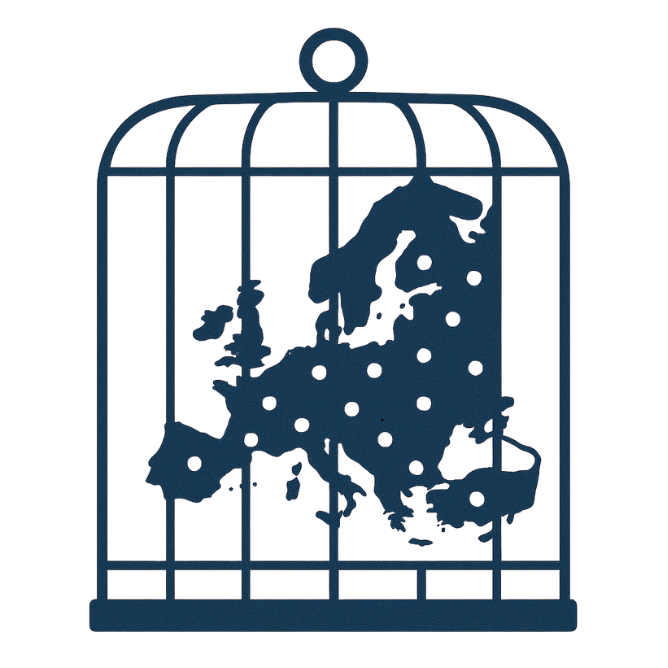Unlocking the
Trapped Value
in European Tech Scaleups

By Rafael Karamanian
Founder and Managing Partner at Lendity

A Silent Crisis in the European Cap Tables
After analyzing more than 150 Swiss and European tech companies over the past two years, one truth has become impossible to ignore: there is an enormous amount of dormant value trapped within the very companies that could define Europe's next tech chapter.
Many of these companies have strong revenues, loyal customers, and resilient products, yet they remain stuck in structural complexity. The main challenge today lies in ownership structures and incentives that no longer serve the companies’ potential.
- Fragmented cap tables with 10 to 20 small investors and no clear leadership
- Founders holding less than 10% after multiple rounds
- Boards trapped in decision paralysis
- Growth plans delayed by misalignment among shareholders rather than lack of opportunity
To unlock this value, the European ecosystem needs to rebuild ownership focus, restore governance clarity, and empower the people who can move companies forward.
The Post-Bubble hangover
The boom years between 2018 and 2021 filled the market with capital and optimism. Founders raised quickly, accepted heavy dilution, and chased scale above structure.
When the liquidity cycle turned, many of those companies were left mature enough to survive yet unable to progress.
- IPO markets closed
- Acquisition activity slowed
- Shareholder groups became too fragmented to act decisively
At Lendity, we refer to these firms as trapped ones, strong, capable companies that have lost the structural conditions needed to advance.
In our dataset of 150+ Swiss tech scaleups:
- The median founder ownership is below 15%.
- Over 40 % of boards composed of 5 members without a controlling group.
- The majority of companies show healthy gross margins and sound unit economics, yet struggle to access new capital due to misaligned interests.
The result? Value is frozen.
 When Ownership Fragments,
Leadership Weakens
When Ownership Fragments,
Leadership Weakens
Once founders hold too little equity, motivation declines. When investors pursue different objectives, governance loses direction. Together, these forces drain companies of the clarity needed to execute.
We meet these situations every week. Tech scaleups with reliable revenues and strong customers are often led by founders who are exhausted, over-diluted, and surrounded by outdated shareholder structures that limit momentum.
The New Complexity: The AI Investment Paradox
Artificial intelligence has added another layer of confusion. Startups now operate with entirely new cost structures, data dependencies, and business models. Investors struggle to distinguish between genuine AI-driven value creation and repackaged technology with an AI veneer.
This creates a dangerous cocktail: founders chasing AI narratives to attract capital while existing investors demand proof of fundamental economics. The gap between story and substance widens. Companies get caught in the middle, unable to articulate coherent unit economics or defensible moats in a landscape where everyone claims AI differentiation.
Without standardized ways to evaluate efficiency, AI-driven companies are difficult to benchmark. Understanding true customer acquisition costs, retention metrics, and margin structures becomes the dividing line between capital that builds and capital that burns. Companies that master this will avoid becoming the next generation of AI-era “zombies”.
The gap between story and substance widens. Companies get caught in the middle, unable to articulate coherent unit economics or defensible moats.
Signal vs. narrative
Investors struggle to distinguish between genuine AI-driven value creation and repackaged technology with an AI veneer.
Benchmarking is hard
Without standardized ways to evaluate efficiency, AI-driven companies are difficult to benchmark.
The dividing line
Understanding true CAC, retention, and margins separates capital that builds from capital that burns. Mastery avoids AI-era “zombies”.
The Anatomy of a Trapped Company
Company A is a B2B SaaS platform with 5M in ARR, 110% net revenue retention, and a path to profitability. The founder holds 6% equity after four dilutive rounds. Three different VC funds sit on the cap table, none with more than 10%-12% ownership. Board meetings discuss survival rather than strategy. The founder is exhausted. Other co-founders have dead equity and don't work there anymore.
Company B is a fintech with genuine competitive moats and modest growth but three years of bridge rounds behind it. The cap table looks like an archaeological dig: preferred stacks, liquidation preferences, anti-dilution protections, and option pools that expired unexercised. Nobody, including the founders, can clearly explain what happens in an exit scenario.
These companies share a common pathology:
- Fragmented ownership leads to governance paralysis
- Founder dilution causes motivation collapse
- Investor misalignment creates strategic inertia
- No clear exit path means trapped capital
And yet they generate revenue. They employ talented people. They solve real problems. The value is there. It's just locked.
Why Traditional Venture Capital Struggles to Help
The venture model was designed for binary outcomes: massive exits or write-offs. It wasn't built to manage the messy middle where companies are viable but outside venture-scale, profitable but without hyper-growth, valuable but lacking explosive potential.
When market conditions were frothy, this misalignment didn't matter. Growth covered structural problems. Down rounds could be avoided by raising "up and to the right." Founders could defer governance problems by promising the next milestone.
That era is over.
Today's European tech ecosystem faces a liquidity crisis rather than a viability crisis. Over 1,200 venture-backed unicorns globally remain un-exited. In Switzerland and the DACH region specifically, we estimate several hundred growth-stage companies are stuck in this zone: too mature for venture appetite, too small or complex for private equity, too operationally sound to simply shut down.
The result? Founders burn out. Employees leave. Competitors catch up. And billions in enterprise value slowly erode.
The Way Forward: Recapitalization Through Clarity
Unlocking Europe's trapped value requires a new playbook that blends capital discipline, governance clarity, and data transparency.
From our work at Lendity, we've identified three strategic levers that can unlock trapped value:
- Rebuild Alignment Through Recapitalization
Create mechanisms for minority and misaligned investors to exit at fair value while concentrating control among those committed to the long-term build. Simplify ownership by consolidating smaller shareholders into structured vehicles. Reinforce leadership incentives through meaningful equity participation. Introduce performance-linked financing that rewards execution and progress.
- Re-Incentivize Founders
Equity dilution creates an existential problem. When founders no longer benefit materially from the upside they're creating, organizations lose their animating force. We call these situations "founders out of the money," akin to equity options trading.
We advocate for systematic founder reloads: new equity grants, profit participation, or performance-based options that restore meaningful ownership. These should be structured as forward-looking incentives tied to cash generation and strategic milestones.
The human side matters. Founders are Europe's most undervalued asset class. When they're exhausted and diluted, innovation slows.
We advocate for founder re-equitization structures that reload incentives to restore meaningful ownership to those still building the business. This represents capital efficiency in action. The best investment is often in the people who already know the business best.
- Institutionalize Reporting and Intelligence
The other half of the problem is informational chaos. Many scaleups can't tell a coherent financial story because they lack structure rather than performance.
This becomes especially critical in the AI era. When everyone claims AI-driven growth, the ability to demonstrate actual unit economics, margin improvement, and efficiency gains becomes the ultimate differentiator. Clear metrics cut through narrative fog.
Most companies need (but lack) investor-grade insights on an ongoing basis. When they have standard and clear reporting (ARR, NRR, burn multiple, efficiency ratios), they unlock three things:
- Board confidence
- Access to better capital
- Higher exit readiness
Consistent, credible reporting builds the foundation of trust and liquidity.
The fundamental problem involves information asymmetry. Investors don't trust the numbers. Founders can't articulate their path to profitability.
Companies need solid insights and governance. We operate with that lenses, enabling us to:
- Identify fundamentally sound companies trapped in bad structures
- Underwrite risk with precision, even in volatile markets
- Provide portfolio companies with investor-grade reporting that rebuilds trust
- Surface early warning signals before liquidity crises become solvency crises
The companies that survive the current correction will be those that earn credibility through transparency.
Unlocking Europe's trapped value requires a new playbook built on clarity, discipline, and transparency.
Rebuild Alignment
Consolidate ownership and give committed leaders real control. Reward execution with performance-linked financing.
Re-Incentivize Founders
Restore meaningful ownership through new equity, profit participation, and milestone-based rewards.
Institutionalize Transparency
Standardize investor-grade reporting to rebuild trust, attract capital, and enable informed governance.
The European Opportunity
Europe, and Switzerland specifically, is uniquely positioned to lead this recapitalization era.
Why? Because European venture already operates under stricter financial norms than Silicon Valley. We have less tolerance for hype, more respect for unit economics, and deeper cultural ties to the Mittelstand ethos of building durable, profitable businesses.
European VCs being more interested in the hard numbers that reflect sustainable business models is our competitive advantage.
While US tech finance remains trapped in the binary logic of unicorns or bust, Europe can pioneer a third model: disciplined growth companies funded through hybrid capital structures that balance equity, debt, and incentive alignment.
These are the companies that can build the invisible growth engine for Europe. They generate cash, compound value, and build institutions.
From Frozen to Flowing: The Next Chapter for European Tech
The market correction that began in recent years represents a shift in how value will be created. It is guiding the ecosystem away from expansion at any cost and toward structured, measurable, and resilient growth.
| Previous Cycle | Emerging Cycle |
|---|---|
| Growth prioritized above all else | Capital-efficient growth |
| Default to equity | Fit-for-purpose capital stack |
| Board gridlock | Controlling coalition |
| Storytelling metrics | Investor-grade KPIs |
The future belongs to founders and investors who combine capital with clarity.
What Lendity Believes
We believe the next generation of European technology leaders will be written by the ones running companies that emerged from the 2020 to 2025 bubble with discipline, clarity, and renewed purpose.
We believe capital and intelligence are inseparable. You cannot fund responsibly without understanding financial health deeply.
We believe founders matter. The best companies are built by operators who care deeply, see clearly, and benefit meaningfully. Any financial structure that decouples founders from long-term value creation is destined to fail.
Europe's trapped tech value represents a reorganization opportunity on a continental scale. If the U.S. venture ecosystem is entering its age of reckoning, Europe can lead the age of refinement, an era defined by sustainable, well-governed, capital-efficient tech champions rather than unicorn headlines.
We believe Europe can lead a new era of disciplined, data-literate, and resilient innovation.
We believe trapped value is unlocked when incentives, decision rights, and capital are redesigned together. Our practice starts with a clear ownership and governance map, couples it with a fit-for-purpose finance layer, and installs a monthly investor-grade reporting rhythm. In our experience, this combination restores strategic options, attracts the right capital, and gives founders their time back without defaulting to unnecessary dilution.
If you're a founder, investor, or board member navigating cap table fragmentation, data chaos, lack of insights, governance paralysis, or liquidity constraints, we would like to talk.
Let’s unlock what is already built.
This article reflects the analysis and opinions of Lendity's investment team, based on firsthand experience with over 150 Swiss and European technology companies. It is intended for informational purposes and does not constitute financial or legal advice.
Build smarter. Scale faster. Give up less.
Join 400+ founders getting our monthly insights on capital and growth.
Learn more about Funding Strategies

The Headcount Control Tower: How to Scale Efficiently by Tying Hiring to Revenue
Tag: Funding Strategies

The Capital Stack: A Guide Not to Accidentally Selling Your Entire Company
Tag: Funding Strategies

SeedStrapping: Why Your Next Round Might Be Your Worst Decision
Tag: Funding Strategies
